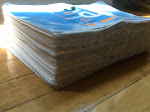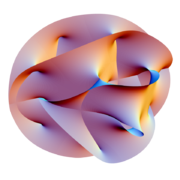
(Burns is in black. I am in red.)
Page:
12 - the kind of emptiness in high talent that Wallace found at the end of his mathematical career
14 - idea of art being a living transaction between humans
15 - his goal of human connection
19 - flows of data more vast than anything the world has seen before
- Ulysses - a kind of encyclopedia
- Joyce - an attempt at "containing the encyclopedia"
20 - "scrotum-tightening", "telemachry"
- the novel is stalked by the ghost of a tall alcoholic author named Jim
29 - his aim is not linear simplification, but to show how one story has "to do with a context created by a larger narrative system of which this piece was a part".
- Infinite Jest's three narratives are designed to suggestively interact, illustrating how individual action effects and is shaped by a larger community
39 - search for an adequate understanding of the self
- "who's there?"
- cold room
- "I am in here."
- empty
40 - somebody unresponsive is there
- no matter how expansive your vocabulary, or how careful your description, a list of words is not enough to make a self
41 - "neither quite a nerd nor quite a jock"
42 - Hal has understood himself "for years as basically vertical," and as his lack of depth begins to depress him...
43- Arizona Garage Scene between James O. Incandenza and his father
- Perhaps most importantly Infinite Jest is a novel that explores the different ways "fathers impact sons"
- "you're a machine"
- seminal definition of what a self is
44 - Wallace attempts to do something real American
46 - Self-forgetting
- The Show
47 - Gaudeamus Igitur: let us rejoice
49 - Hal feels at his own face to see if he's wincing
- insufficient free will
50 - charts the progressive erasure of identity by the pressures of family and academy
51 - beginning with a confident "I" the narrative proper ends with "he"
52 - Erdedy reflects on the light streaming onto the floor (the way I did when I put Mount Jest on the floor of my room? Am I a pot head?) and on the insect (take note Abbot)
53 - To locate the local in larger perspectives
- cool analysis: Burn refers to the coffee cup that knocks on the door ("like the rap of a knuckle", p. 480) of Antitoi Entertainment as Gately drives by the place that houses the Infinite Jest cartridge that he originally stole: Burn likes this small narrative circle (for those who don't believe that there was no narrative line at all, Burn demonstrates how in one small, tight moment, Wallace is able to bring the narrative together then loop of again
54 - emergent networks
- "systems inside systems" of natural ecologies
55 - a novel that is partly about the returning dead
- Robert Coover's The Universal Baseball Association
56 - Wallace does seem to have attempted to create a mythology
57 - Madame Psychosis = metempsychosis: migration of the soul from one body to another
- there is little in this long book that does not serve some larger purpose
- parallels between Heracles and Gately
58 - during the "missing year" between YDAU (2009) and Glad (2010): "Don Gately and I dig up my father's head."
(Hmm - is Gately alive then? Or maybe this explains why Hal finishes the story speaking like the devil and blowing his admissions interview: he has been to hell/the Underworld?; he has been with Gately? Is Gately now the ghost? And is Himself the head/skull of Yorrick > "a fellow of Infinite Jest (the film)? (In Hamlet the ghost was apparently in Purgatory - like maybe Gately?))
59 - Dymphna is a Catholic saint
60 - raises the possibility that Infinite Jest is basically a religious book
- the novel is about belief
- the spiritual hollowness of a life without belief seems to be one of the most persistent themes
- Wallace interview with Review of Contemporary Fiction: "To me, religion is incredibly fascinating as a general abstract object of thought - it might be the most interesting thing there is. But when it gets to the point of trying to communicate specific or persuasive stuff about religion, I find I always get frustrated and bored. I think this because the stuff that's truly interesting about religion is inarticulable." (Is this like Einstein's view of religion?)
61 - the novel intimates that belief may provide, as the last words hint, a "way out" (or the answer is way out there?)
64 - festival of the dead
65 - Infinite Jest is clearly a book with "wide-ranging and deeply hidden themes having to do with death and time"
- narratives clearly move toward an apocalyptic collision
- 2010 is the very last year of ONANite Subsidized Time
68 - Kakutani of the New York Times said that the book "often seems like an excuse for Mr. Wallace to simply show off his remarkable skills as a writer and empty the contents of his restless mind".
74 - Cioffi's essay talks about the experience of reading the book
75 - Joseph Tabbi's Cognitive Fictions provides an interesting response to earlier criticism as it breaks with the prevailing trend of considering IJ as an extension of Pynchon's work
76 - Zadie Smith expressed admiration for Wallace's work: "Wallace is proving to be the kind of writer I was sort of hoping didn't exist - a visionary, a craftsman, a comedian and as serious as it is possible to be without writing a religious text"
(Nice words from Zadie. It's true: vision, craft, high humour, seriousness - but clearly not dogmatic like the Bible - given the elussive narrative, the inconclusive ending and the creation of a book that is more puzzle and game than it is two stones being brought down from a mountain.)
---
Burns gets at a lot of stuff that I didn't make note of with my pencil marks. The pencil marks were I guess more personal than explaining what Burns concludes. (I guess you'll have to read that for yourself!) Burns does a very good job in a very few pages in putting IJ in a literary context - making interesting references to writers and books that IJ was maybe based on or better yet tried to contain. Burns talks a lot about Joyce and Ulysses and DeLillo and Underworld. Burns also does a good job of clarifying the narrative and the timeline in IJ. A worthwhile quick read. Thanks Abbot!


